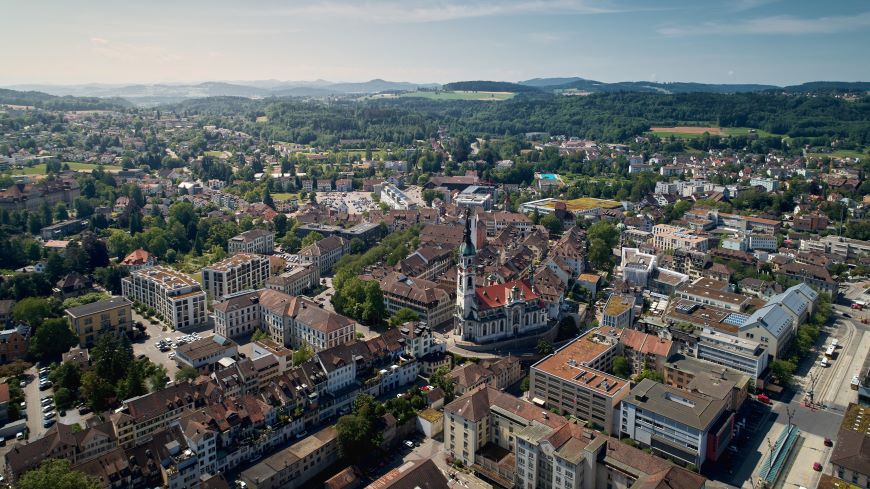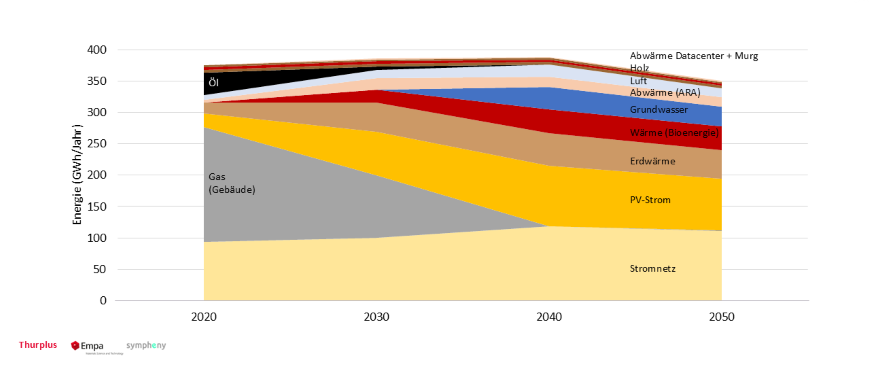Energy perspectives for the city of Frauenfeld
Digital solutions pave the way to net-zero
After a two year-project, Thurplus, the city of Frauenfelds's utility company, and Empa last Wednesday presented the report, Energy Perspectives 2050. The project sheds light on energy scenarios from today to 2050, extrapolated from around 20,000 smart meter data sets. The conclusion of the study: Net zero is feasible – the key lies in district heating and replacing conventional, fossil heating systems.

The city of Frauenfeld is pursuing the ambitious goal of becoming climate-neutral by 2050. An important milestone on this path is the complete phase-out of fossil fuels for heating by 2040. Today, around 80% of buildings in Frauenfeld are still heated with oil or gas. This dependency poses major challenges for the city and its utility company, Thurplus, in terms of security of supply and economic efficiency in the transition to renewable energies.
In order to tackle these challenges, Thurplus initiated the project Energy Perspectives Frauenfeld 2050 in spring 2023, which is led by Empa's Urban Energy Systems Lab under the direction of Matthias Sulzer and Georgios Mavromatidis and supported by the expertise of Empa spin-off Urban Sympheny in the field of energy systems modeling. By combining Thurplus data from around 20,000 smart meters, electricity and gas meters and statistical building data with state-of-the-art energy optimization models, the project identified realistic and cost-efficient solutions for a climate-neutral future.
In close cooperation with Thurplus, scenarios from the Energy Future 2050 study by the Association of Swiss Electricity Companies (VSE) were adapted specifically for Frauenfeld. These scenarios show which technologies, energy requirements and infrastructures are necessary to achieve net-zero emissions.
The study's take-home message: Net zero is feasible through coordinated energy planning
Decarbonization is possible with today's technologies: Climate neutrality is achievable with technologies that are already available, such as district heating, heat pumps, photovoltaics (PV) and battery storage. However, this requires the rapid introduction of these technologies and the maintenance of the current renovation rate for energy-efficient building refurbishment.
Replacing fossil heating systems is essential: In 2023, over 4,000 property owners in Frauenfeld were still using oil and gas heating systems. To completely replace these fossil fuel systems by 2040, around 250 buildings would have to switch to renewable heating solutions every year.
A central heating supply is more cost-effective: In urban areas, district heating is cheaper than decentralized heating solutions. While district heating currently only covers around 4% of Frauenfeld's heating requirements, this proportion could rise to over 50% by 2050. Ideally, the potential for high energy density should be exploited in areas suitable for district heating.
Solar power has great potential: Photovoltaic systems currently cover around 18% (21 GWh/year) of Frauenfeld's electricity requirements. By expanding PV output to around five times its current capacity, this share could increase to up to 45% (97 GWh/year) by 2040.

Economic efficiency can be achieved through coordinated planning: Coordinated planning and implementation that takes into account the local conditions of the neighborhoods in Frauenfeld reduces the overall costs of the energy system and shows that a renewable energy supply is economically viable. Nevertheless, a considerable investment is required, and it is crucial that the necessary financial resources are available.
The Energy Perspectives Frauenfeld 2050 project recommends the coordinated expansion of climate-friendly technologies such as district heating, heat pumps, photovoltaic systems, electric vehicles and battery storage, while at the same time consistently pursuing the energy-efficient renovation of buildings. Moreover, careful planning of electricity and heating grids in line with the net-zero pathway is required, as well as flexible solutions such as energy storage and intelligent energy use by consumers.
The results show how data-based models and cross-sector collaboration can help cities develop robust, economical and sustainable strategies for the energy transition. They provide a solid basis for decision-making for politicians, utility companies and citizens and serve as a model for other Swiss municipalities on the path to climate neutrality.
The results of these energy perspectives now form the basis for general energy planning and, more specifically, for the revision of the energy master plan, the further expansion of district heating and electrical grid planning for the city of Frauenfeld. The project was supported by the Swiss Federal Office of Energy (SFOE), the Office for Energy of the Canton of Thurgau and the Office for Building Construction and Urban Planning of the city of Frauenfeld.
Dr. Michael Hagmann
Communications
Phone +41 58 765 4592
redaktion@empa.ch
-
Share






